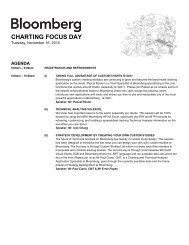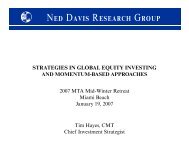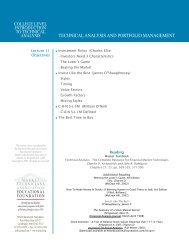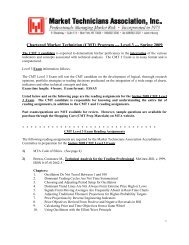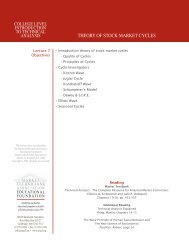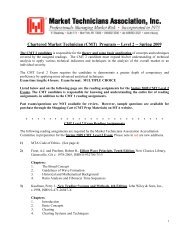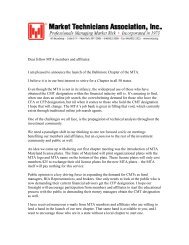Journal of Technical Analysis - Market Technicians Association
Journal of Technical Analysis - Market Technicians Association
Journal of Technical Analysis - Market Technicians Association
You also want an ePaper? Increase the reach of your titles
YUMPU automatically turns print PDFs into web optimized ePapers that Google loves.
The war <strong>of</strong> 1812 was the period in history <strong>of</strong> the United States <strong>of</strong> America when it was deemed a necessity for this country a manufacturing nation, as a balance<br />
wheel, to maintain the prosperity <strong>of</strong> agriculture and commerce, and also to declare her independence forever from any nation upon the earth.<br />
It is a doleful commentary upon the times that such calamities in the history <strong>of</strong> our country, as hereafter mentioned, should have occurred amidst a pr<strong>of</strong>usion <strong>of</strong><br />
all the elements <strong>of</strong> wealth, prosperity in trades and manufactures, and independence in the arts and sciences.<br />
It will only be necessary for the purposes <strong>of</strong> this book to state that the business <strong>of</strong> this country before, during, and after the war <strong>of</strong> 1812 had culminated in the<br />
year 1819, as commercial history will show; and that a reaction in business followed this year, the beginning year in our cycles <strong>of</strong> commerce and panic.<br />
However, we deem it important to notice at this period the operations <strong>of</strong> banking in brief as a good criterion <strong>of</strong> the prosperity or adversity in general business,<br />
and the fluctuations in the activity <strong>of</strong> industry and commerce.<br />
In the Report <strong>of</strong> Finances for 1854 and 1855, it is stated that the adoption <strong>of</strong> the Federal Constitution in 1787 to the year 1798, no people enjoyed more happiness<br />
or prosperity than the people <strong>of</strong> the United States, nor did any country ever flourish more within that space <strong>of</strong> time. During all this time, and up to the year 1800,<br />
coin constituted the bulk <strong>of</strong> the circulation; after this year the banks came, and all things became changed, like the Upas tree, they have withered and impaired the<br />
healthful condition <strong>of</strong> the country, destroyed the credit and confidence which men had in one another.<br />
The bank-note circulation began to exceed the total specie in the country in the years 1815, ’16, and ’17, and in the year 1818, the bank mania had reached its<br />
height; more than two hundred new banks were projected in various parts <strong>of</strong> the Union. The united issues <strong>of</strong> the United States Bank, and <strong>of</strong> the local banks, drove<br />
specie from the country in large quantities, and in the year 1819, when the culmination in general business had been reached, and contraction <strong>of</strong> the currency began<br />
to be felt, multitudes <strong>of</strong> banks and individuals were broken. The panic producing a disastrous revulsion in trade, caused the failure <strong>of</strong> nine-tenths <strong>of</strong> all the merchants<br />
in this country and others engaged in business, and spread ruin far and wide over the land.<br />
Two-thirds <strong>of</strong> the real estate passed from the hands <strong>of</strong> the owners to their creditors.<br />
A banker, in a letter to the Secretary <strong>of</strong> State, in 1830, describes the times as follows;<br />
“The disasters <strong>of</strong> 1819 which seriously affected the circumstances, property, and industry <strong>of</strong> every district <strong>of</strong> the United States will be long recollected.<br />
A sudden and pressing scarcity <strong>of</strong> money prevailed in the spring <strong>of</strong> 1822; numerous and very extensive failures took place in 1825; there was great<br />
revulsion among the banks and other monied institutions in 1826. The scarcity <strong>of</strong> money among the trades in 1827 was disastrous and alarming; 1828 was<br />
characterized by failures among the manufactures and trades in all branches <strong>of</strong> business.”<br />
After the year 1828 business continued to be depressed, vibrating according to circumstances until 1834, a year <strong>of</strong> extreme dullness in all branches <strong>of</strong> trade;<br />
after which our stock <strong>of</strong> precious metals increased very fast, business revised, and in the year 1835 and ’36, the imports <strong>of</strong> gold and silver increased to an enormous<br />
extent; as the banks increased their reserves <strong>of</strong> species, they also correspondingly issued bank notes – each increased issue <strong>of</strong> paper money led to the establishment<br />
<strong>of</strong> new banks.<br />
The State banks that had numbered in 1830 only three hundred and twenty-nine, with a capital <strong>of</strong> one hundred and ten millions, increased, according to the<br />
treasury report, by the first <strong>of</strong> January, 1837, to six hundred and twenty-four, or, including branches, to seven hundred and eighty-eight, with a capital paid in <strong>of</strong> two<br />
hundred and ninety millions.<br />
Mark the result and culmination; a panic! In the month <strong>of</strong> May, 1837, a suspension <strong>of</strong> specie payments by all the banks, and a general commercial revulsion<br />
throughout the country, involving the fortunes <strong>of</strong> merchants, manufacturers, and all classes engaged in trade, in consequence <strong>of</strong> a ruinous fall in prices. This year <strong>of</strong><br />
reaction makes the second year in our panic cycles, and is eighteen years from 1819.<br />
It is not necessary to go over almost the same history again to show that business was depressed, and trade was stagnant after 1837 down to the year 1843, and then<br />
up and down to the year 1850, a year <strong>of</strong> extreme dullness in all branches <strong>of</strong> trade and industry, after which year a change came, and business was again prosperous to the<br />
year 1857, when we again experienced a commercial and financial crisis and reaction, not only in this country but all over the world, making the third year in our cycles,<br />
and twenty years from 1837.<br />
History repeats itself with marvelous accuracy in detail from one panic year to another. The general direction <strong>of</strong> business after the panic <strong>of</strong> 1857 was on the same<br />
downward grade that had characterized the times after the panic <strong>of</strong> 1819 and 1837, until all business had culminated in depression in the year 1861, after which trade<br />
again improved, and was very active during the war <strong>of</strong> the rebellion and up to the year 1865, when a temporary reaction set in. Reader let me observe here, that if then<br />
had been the time for a commercial revulsion and panic in money, the catastrophe would have been the most deplorable national calamity upon record. However, the<br />
cycle was not then complete. And the commerce and trade <strong>of</strong> the country continued to be semi-prosperous until 1870, after which year commercial activity was the<br />
order <strong>of</strong> the day, all branches <strong>of</strong> business and manufacture flourished and was prosperous; our railroad building was astonishing in the world in the years 1871, ’72;<br />
but the end must come, and in September 1873, we had the culmination – a crashing panic, and reaction in all trades, manufactures, railroads, and industries, which<br />
is still going on, and we have not reached hard pan.<br />
These are facts <strong>of</strong> late history, and are so fresh in the recollection <strong>of</strong> the mind <strong>of</strong> the reader, that it is only necessary to refer to them. The panic <strong>of</strong> 1873 makes<br />
the fourth year in our panic cycles, and sixteen years from 1857.<br />
As to whether it is the paper money or the manufacturing and trading industries <strong>of</strong> the country, which call out and into use the paper money that produce these<br />
periodical inflations and contractions, by which trade is stimulated and deranged, and extremes in business activity is brought about, is a matter for the statesman and<br />
historian to ascertain and record; [ ed note – the first book written was by a technical analyst and not a fundamentalist.] it is only sufficient for our purposes to point<br />
out the years, and to show that the preceding years were prosperous and pr<strong>of</strong>itable years in trade; while the succeeding years, for a certain length <strong>of</strong> time, were years<br />
<strong>of</strong> depression and loss in business; and we observe that since the business <strong>of</strong> the country has abandoned specie (ed note, gold and silver) as a currency, and adopted<br />
paper money in lieu there<strong>of</strong>, the manufacturing interests have attained larger proportions, and that there are more regularity and system in the return <strong>of</strong> the advance and<br />
decline in general business, and that the culminating years in activity and depression can be calculated and ascertained with greater certainty.<br />
The panics <strong>of</strong> 1819, ’37, ’57, and ’73, during this period <strong>of</strong> years, stand out upon the pages <strong>of</strong> history <strong>of</strong> this country in their magnitude compared with other<br />
panics. (ed. Text removed.)<br />
Commencing with the commercial revulsion <strong>of</strong> 1819, we find it was eighteen years to the crisis <strong>of</strong> 1837, twenty years to the crisis <strong>of</strong> 1857; and sixteen years<br />
to the crisis <strong>of</strong> 1873 – making the order <strong>of</strong> cycles sixteen, eighteen, and twenty years and repeat. The cycle <strong>of</strong> twenty years was completed in 1857, and the cycle<br />
<strong>of</strong> sixteen years ending in 1873, was the commencement <strong>of</strong> the repetition <strong>of</strong> the same order. It takes panics fifty-four years in their order to make a revolution, or to<br />
return in the same order; the present cycle consisting <strong>of</strong> eighteen years will end in 1891, when the next panic will burst upon us with all its train <strong>of</strong> woes. 2<br />
Jo u r n a l <strong>of</strong> <strong>Technical</strong> <strong>Analysis</strong> • 2008 • Issue 65 57




